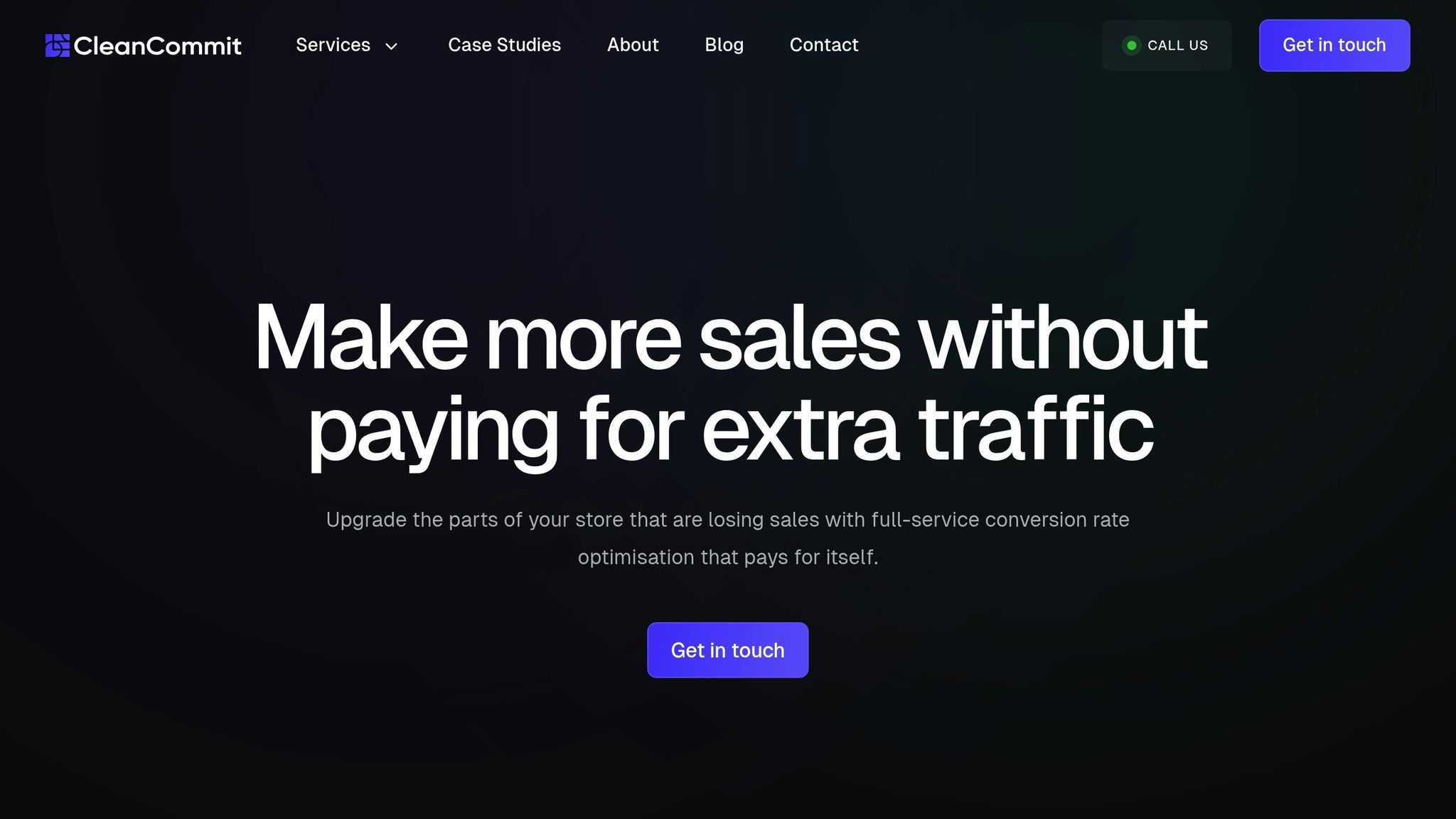5 Common Shopify Conversion Killers & How Our 30-Day Trial Can Fix Them
Most Shopify stores convert only 1.4% of visitors, far below the top performers at 4.8% or more. That gap could mean thousands of dollars in lost revenue. The good news? Fixing common conversion blockers can transform your store into a sales powerhouse.
Here’s what’s holding your store back:
- Clunky Checkout: Hidden fees, forced account creation, and complicated steps drive away 70% of shoppers.
- Weak Product Pages: Missing details, poor images, and lack of trust signals make buyers hesitate.
- Slow Load Times: A 1-second delay can cut conversions by 7%, especially on mobile.
- Generic Experiences: Shoppers expect personalized recommendations, not one-size-fits-all.
- No Data-Driven Changes: Guessing what works wastes time and money.
How to fix it:
Our 30-day free trial tackles these issues with proven strategies like checkout optimization, mobile-first design, and A/B testing. Results? Increased conversions, higher revenue, and happier customers - all without upfront costs.
Want to boost your Shopify store’s performance? Start by fixing these five common problems.
Shopify Store Teardown: 3 High-Impact CRO Fixes (From 80+ Store Analysis)

5 Common Shopify Conversion Killers
Even the best-designed Shopify stores can struggle with conversion rates if they fall into these five common traps. Each of these issues creates hurdles in the customer journey, ultimately costing sales.
1. Poor Checkout Experience
The checkout process is where most sales either succeed or fail. The numbers are alarming: 70.19% of online retail orders are abandoned, with U.S. and EU markets losing a jaw-dropping $260 billion in recoverable orders due to poorly designed checkout flows.
Unexpected costs like shipping, taxes, and fees are the leading cause, driving 48% of cart abandonments. When customers encounter surprise charges at checkout, they feel misled and leave. U.S. shoppers, in particular, expect pricing transparency throughout their shopping experience. Additionally, 63% of online shoppers abandon their cart when they can’t check out as a guest, and 26% leave if forced to create an account. Lack of mobile wallet options also drives away 40% of shoppers.
Security concerns add another layer of friction. 25% of shoppers abandon their cart over credit card security worries, while 19% leave because they don’t trust the site with their payment information.
While checkout problems are a dealbreaker, weak product pages can erode trust long before customers reach that stage.
2. Weak Product Pages
Think of your product pages as your online sales team - if they’re ineffective, conversions will suffer. 85% of shoppers say product information and images are key factors when choosing between brands, yet many Shopify stores fail to provide the details customers need to feel confident about their purchase.
Poor product descriptions are a major culprit. If your copy doesn’t address customer needs or highlight specific benefits, shoppers are left unsure about the product’s value. When customers can’t see how a product solves their problem or improves their life, they’re unlikely to buy.
Low-quality images and minimal product details further damage trust. With more than 60% of U.S. e-commerce purchases happening on smartphones, blurry or insufficient photos make your store look unprofessional. Customers want to see multiple angles, lifestyle images, and zoom capabilities to feel assured of their choice.
Missing trust signals, like customer reviews, security badges, or clear return policies, create even more hesitation. For new brands, these elements are critical to building credibility in the competitive U.S. market.
Mobile optimization is another common weak spot. With over 58% of traffic coming from mobile devices, a poorly designed mobile experience - think tiny text or hard-to-click buttons - can drive shoppers away in frustration.
"The paramount goal for your product pages should be to build user confidence by providing all the information necessary for a purchasing decision and making the process as intuitive and straightforward as possible." - Rosara Joseph, content strategist at VentureWeb
But even the most polished product pages can’t overcome the damage caused by a slow-loading site.
3. Slow Site Speed and Poor Mobile Design
Speed matters - a lot. Nearly 70% of consumers admit that page speed influences their decision to buy. A 1-second delay in page load time can result in a 7% drop in conversions, and bounce rates jump 32% when load times increase from 1 to 3 seconds.
Mobile users are particularly unforgiving. 53% of users will abandon a page if it takes longer than 3 seconds to load, and 90% of shoppers leave e-commerce sites due to slow mobile performance. With mobile e-commerce sales hitting $2.2 trillion in 2023, accounting for 60% of global e-commerce sales, a clunky mobile experience - like non-responsive layouts or hard-to-navigate menus - can send customers running to competitors. Worse, 62% of consumers say they won’t return to a site after a poor mobile experience.
The payoff for improving speed is undeniable. In 2024, Rakuten 24 increased its conversion rate by 33.13% and revenue per visitor by 53.37% after optimizing its Core Web Vitals. Similarly, redBus saw a 7% sales boost after improving its site performance.
4. Generic Shopping Experience
Today’s shoppers want more than a one-size-fits-all experience. Generic product recommendations, irrelevant promotions, and cookie-cutter messaging fail to engage an audience that’s overwhelmed with options.
Without personalized product suggestions based on browsing history or past purchases, you miss opportunities to upsell or cross-sell. This not only reduces average order value but also makes the shopping experience feel impersonal.
Tailored promotions are equally important. Shoppers expect discounts in their local currency, seasonal offers that match their region, and acknowledgment of local holidays or trends. Ignoring these nuances can make your store seem out of touch.
Personalization should extend to your website’s layout and messaging. Stores that don’t adapt their homepage, featured products, or banners based on customer behavior miss valuable chances to guide shoppers toward relevant items and boost conversions.
5. Making Decisions Without Data
Running a Shopify store based on instincts instead of data is like driving blindfolded. Without A/B testing and analytics, you’re guessing at what works - and often guessing wrong.
Many store owners make changes based on personal preferences or industry fads without testing their impact on their audience. This can backfire, as what works for one store might not work for yours.
Failing to track key metrics like traffic sources, cart abandonment rates, or checkout bottlenecks leaves you in the dark about what’s really affecting conversions. Given that only 2% of e-commerce site visits result in a purchase, it’s crucial to pinpoint where and why visitors drop off.
Data-driven stores have a clear advantage. They continuously refine their strategies through testing and optimization, while stores relying on assumptions risk wasting time and resources on ineffective changes. In the fast-paced U.S. e-commerce market, this can mean falling behind competitors who are leveraging data to stay ahead.
How Clean Commit's 30-Day Trial Fixes These Conversion Killers

Clean Commit's 30-day free trial is designed to address common conversion issues faced by U.S.-based Shopify stores. During this trial, we run up to three experiments to show how data-backed optimizations can transform your store's performance - all without upfront costs or long-term commitments.
Checkout Fixes
A poor checkout experience is one of the biggest reasons shoppers abandon their carts. To tackle this, we analyze your checkout process to find and fix problem areas like hidden fees, forced account creation, and overly complicated steps.
Upfront pricing transparency is key. We ensure all costs - like shipping, taxes, and additional fees - are displayed in USD before customers reach the final checkout step. Shipping calculators are added to product pages so shoppers know exactly what they'll pay before adding items to their cart.
Guest checkout is another game-changer. By enabling guest purchases and reducing hidden fees, we simplify the process. For those who want to create an account, we move that option to post-purchase, removing unnecessary hurdles.
We also streamline the checkout process by reducing steps and fields, helping customers complete their purchase in four minutes or less - matching the expectations of two-thirds of shoppers. Popular U.S. payment options like Apple Pay, Google Pay, PayPal, and buy-now-pay-later services are added for convenience.
To address security concerns, we strategically place trust signals like SSL certificates, security badges, and trusted payment provider logos throughout the checkout process. This reassures the 25% of shoppers who worry about credit card security.
Product Page Improvements
Optimizing product pages is all about building shopper confidence. We start by evaluating your current pages to identify weak spots that may be holding back conversions.
We improve product imagery by adding multiple angles, lifestyle photos, and zoom features, giving customers a better understanding of what they’re buying. For example, Marcella New York uses a combination of angles, lifestyle shots, and even GIFs to showcase products.
Detailed product descriptions are another focus. We go beyond listing features by addressing specific customer needs, such as sizing details, usage instructions, and clear product benefits. This aligns with data showing that 85% of shoppers value product details and images when deciding between brands.
To boost trust, we incorporate social proof. For instance, Iconic London uses user-generated content directly on product pages. This is vital, as 46% of consumers trust online reviews as much as personal recommendations. Additional trust signals, like clear return policies and shipping details, further ease hesitation.
"The paramount goal for your product pages should be to build user confidence by providing all the information necessary for a purchasing decision and making the process as intuitive and straightforward as possible." - Rosara Joseph, Content Strategist at VentureWeb
Site Speed and Mobile Fixes
Slow-loading sites drive shoppers away, especially on mobile devices. With mobile e-commerce sales reaching $2.2 trillion in 2023 and accounting for 60% of global sales, optimizing speed and mobile performance is critical.
Image optimization is a foundational step. We compress and resize images to maintain quality while improving load times. Lazy loading ensures images load only when needed, and we use device-specific file formats for better performance. Even a one-second delay in page loading can reduce conversions by 7%.
Code optimization includes minifying CSS and JavaScript, implementing caching, and using a Content Delivery Network (CDN) to bring content closer to U.S. customers.
Mobile-first design ensures your store works seamlessly on smartphones and tablets. We optimize button sizes for touch navigation, simplify menus, and ensure text is readable without zooming. With 81% of Shopify traffic coming from mobile devices and 62% of consumers unlikely to return after a poor mobile experience, these updates are essential.
Custom Shopping Experiences
Personalization is key to engaging U.S. shoppers. Using analytics, we tailor the shopping experience to match customer behavior and preferences.
Targeted product recommendations replace generic suggestions with smarter options based on browsing history and past purchases, increasing order value and relevance.
Localized promotions align with U.S. shopping trends and holidays. Seasonal offers, USD pricing, and tailored messaging cater to American shoppers, especially during events like Black Friday, Cyber Monday, and back-to-school sales.
Dynamic content adjusts your homepage, featured products, and banners based on customer segments. First-time visitors see different content from returning customers, and mobile users get experiences optimized for their devices.
Behavioral triggers encourage conversions at key moments. Exit-intent popups, time-sensitive offers, and cart abandonment emails re-engage shoppers when they’re most likely to leave. These strategies are constantly refined through testing.
A/B Testing and Data-Based Changes
We rely on A/B testing to validate every change, ensuring measurable improvements. Each test follows a clear hypothesis and tracks metrics to confirm what works.
Performance analysis dives into user flows, heatmaps, and customer feedback to understand why certain changes succeed. This data-driven approach ensures that every dollar you invest in conversion rate optimization services deliver tangible results.
U.S.-Specific Best Practices for Shopify CRO
When it comes to online shopping, American customers have their own set of expectations. Meeting these preferences can make a significant difference in conversion rates and overall sales performance.
Meeting U.S. Customer Expectations
For American shoppers, transparency and trust are non-negotiable. With online scams on the rise, building credibility is critical to converting visitors into buyers.
Start with clear pricing in USD. Display prices upfront without hidden fees - this simple step can increase conversions by up to 12%. Hidden costs at checkout are the leading cause of cart abandonment, so make sure customers know exactly what they’ll pay.
Use the mm/dd/yyyy date format to keep things familiar for U.S. shoppers. It’s a small detail, but it reinforces trust and a sense of localization.
Offer a variety of payment options. From digital wallets like Apple Pay and Google Pay to Buy Now, Pay Later services, giving customers flexibility at checkout is key.
Mobile optimization is a must. Your site should work flawlessly on mobile devices, with responsive design and touch-friendly features that make the checkout process smooth and intuitive.
Address security concerns with trust signals. Display SSL certificates, security badges, and clear return policies. In fact, over 67% of shoppers check return policies before completing a purchase. Make this information easy to find, along with shipping policies.
"Our customers' experience is the most important thing to us. They need to trust our checkout as much as they trust our products–and recognize the path to purchase as easily as they recognize our brand." - Kyla Robinson, vice president of digital product at Spanx
Social proof is another powerful tool. Show customer reviews, ratings, and endorsements prominently to give shoppers confidence in your products. For example, Peepers enhanced their product pages by displaying five-star ratings next to prices and highlighting free shipping and returns policies. This approach helped address value concerns for hesitant buyers.
Brand transparency also plays a big role. Keep your contact information updated, provide a detailed "About Us" page, and ensure consistent branding across your site. These steps reassure customers and make your store feel more reliable.
Don’t overlook regional preferences. Shoppers on the East Coast tend to value efficiency and straightforwardness, while West Coast consumers often prioritize authenticity and social responsibility. Tailor your messaging and promotions to reflect these regional differences.
Using Data for Constant Improvement
Once you’ve laid the groundwork with localized strategies, the next step is to focus on ongoing optimization. Only 2% of top e-commerce sites currently offer an ideal checkout experience, leaving plenty of room for improvement.
A/B testing is essential to validate changes. Test everything - from checkout designs and payment options to messaging and page layouts. Even small tweaks, like reducing unnecessary form fields, can make a difference. On average, only 8 of 11.3 checkout fields are truly necessary.
Use analytics tracking to understand customer behavior. Identify where visitors drop off, which pages perform best, and how traffic sources convert. This data helps you focus your efforts where they’ll have the greatest impact.
Plan for seasonal optimization by aligning with U.S. shopping patterns. Key times like Black Friday, Cyber Monday, back-to-school season, and the holidays offer huge opportunities. Gymshark, for instance, uses banners to clearly communicate shipping costs, delivery times, and discounts, reducing cart abandonment.
Incorporate customer feedback into your strategy. While analytics provide quantitative insights, customer feedback offers a qualitative perspective that can guide more personalized improvements.
Keep an eye on performance metrics to maintain results. While adapting to U.S. shopping habits can increase conversions by up to 70%, these gains require continuous monitoring. Regular audits ensure your site stays optimized.
Finally, consider generational preferences when testing strategies. Younger shoppers often prefer digital wallets or even cryptocurrency, while older customers lean toward traditional payment methods like credit cards or bank transfers. Segment your audience to see how different groups respond to your optimization efforts.
Conclusion: Boost Your Shopify Conversions with Clean Commit
If you're struggling with conversion challenges on Shopify, Clean Commit offers a practical solution to supercharge your store's performance. With the average Shopify conversion rate hovering at just 1.4%, compared to top performers reaching 4.8% or more, there's a huge opportunity to turn things around and increase revenue significantly.
Our 30-day free trial tackles the most common conversion blockers. We simplify the checkout process to address the 18% of cart abandonments caused by complexity. Detailed product descriptions and social proof, like reviews, are added to build trust - especially since 72% of shoppers depend on reviews before making a purchase. We also enhance site speed, where every second saved can boost conversions by 27%, and implement A/B testing strategies that have already generated over $100 million in additional revenue for other stores.
Real-world success stories highlight what’s possible. For instance, Pullup & Dip saw a 348% increase in conversions, Filtrous experienced a 27% organic lift in just a few weeks, and Dr. Axe improved overall rates by 10%, with custom pricing alone driving a 33% boost.
For U.S.-based merchants, we tailor our optimizations to your audience. This includes transparent USD pricing, familiar date formats (mm/dd/yyyy), diverse payment options, and trust signals that resonate with American shoppers. We also focus heavily on mobile optimization, which is critical when 79% of traffic comes from mobile devices. With mobile cart abandonment rates at a staggering 85.65%, our targeted strategies ensure you're not leaving money on the table.
Key Takeaways
Improving your conversion rate from 1.4% to 4.8% could recover thousands of dollars in lost revenue every month. With Clean Commit’s 30-day free trial, you’ll get up to three experiments designed to demonstrate how data-driven changes can transform your store.
During the trial, we’ll pinpoint where your conversions are leaking, create tailored solutions, and implement measurable improvements. Whether it’s reducing cart abandonment, streamlining mobile checkouts, or optimizing product pages, every change is backed by data, not guesswork.
There’s no risk to you - cancel anytime if you’re not satisfied with the results. With proven strategies that have already helped stores achieve conversion lifts of 15–25% through mobile optimization alone, now is the time to take action and reclaim lost revenue.
FAQs
How does Clean Commit's 30-day trial help improve the Shopify store checkout experience and reduce cart abandonment?
Clean Commit offers a 30-day trial aimed at transforming the Shopify checkout process by tackling common issues that lead to cart abandonment. With features like personalized gifting options and free shipping triggers based on order value, it creates a checkout experience that feels more tailored and engaging for shoppers.
The trial also simplifies the process with tools like autofill for shipping and billing details, support for various payment methods, and the option for guest checkouts. These updates help streamline the experience, minimize friction, and speed up the process - making it easier for customers to complete their purchases and increasing the likelihood of conversions.
How does Clean Commit improve product pages and build customer trust during the 30-day trial?
Clean Commit focuses on refining product pages to make shopping as smooth and engaging as possible. They prioritize crisp, engaging product descriptions, high-quality images, and user-friendly layouts to ensure everything is easy to navigate and visually appealing. To fine-tune these elements, they rely on A/B testing to study how customers interact with the pages and adjust for the best results.
Building trust is another cornerstone of their approach. Clean Commit integrates customer reviews, trust badges, and secure payment methods to reassure shoppers and boost confidence in their purchases. Together, these strategies help minimize hesitation and drive more conversions.
How does Clean Commit improve site speed and mobile performance to boost conversions during the trial?
Clean Commit focuses on boosting site speed and improving mobile performance during the trial period, prioritizing faster load times and a seamless browsing experience. Why does this matter? Studies reveal that even minor gains in page speed can lead to noticeable increases in conversions. To make this happen, Clean Commit fine-tunes critical performance metrics like Time to First Byte and First Contentful Paint, ensuring pages load swiftly and efficiently. This not only reduces bounce rates but also keeps visitors engaged.
Here’s how they achieve it:
- Image optimization: Shrinks file sizes without sacrificing quality, ensuring visuals load quickly.
- Lazy loading: Loads only visible content first, speeding up the initial experience.
- Browser caching: Stores data locally to make repeat visits faster.
These enhancements are particularly beneficial for mobile users, where speed and ease of use are key. By delivering a smooth shopping experience, Clean Commit helps your Shopify store retain visitors and encourages them to complete their purchases - supporting conversion growth during the trial and well into the future.


